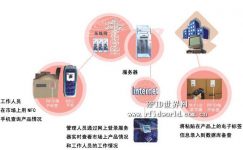
The application scheme of RFID technology in logistics management
[ad_1]
1. Project background
With the development of economic globalization and the rise of the network economy, the global logistics service industry has accelerated development. The development of global economic integration has made the cooperative relations of corporate procurement, warehousing, sales, and distribution increasingly complex. The competition between enterprises is not only the competition of product performance and quality, but also the competition of logistics capabilities. Use information technology to replace actual operations, reduce waste, save time and expense, so as to achieve seamless docking and integration of the supply chain. In order to realize the information management of logistics processes, use information management methods to manage the company’s warehousing and logistics information. , In order to promote data sharing, goods and capital turnover rate, improve work efficiency, and achieve an informatization process synchronized with modern logistics enterprise management.
2. System overview
The “Warehouse Logistics Management System” of Shenzhen Guanyicheng Technology Co., Ltd. is a platform based on RFID identification technology for cargo identification, tracking, management and inspection of cargo information. The system combines advanced RFID identification technology with computer database management and query , Automatic identification of cargo information, the application of this system can greatly save manpower and material resources, the main functions are as follows:
Inventory management: Increased visibility and correct information during the circulation of goods can reduce inventory holding costs and handling costs. In addition, the use of RFID in the entire supply chain can make the product demand forecast of each company more accurate, so it is more convenient in inventory management.
Anti-theft control: All exits are equipped with readers to avoid theft of goods with RFID tags. Reduce losses and incorrect inventory quantities occur.
Equipment utilization rate: Installing RFID tags on the equipment in the factory can also record its movement and use, increasing the utilization rate of the equipment.
Manual operation tracking: used as a labor tracking system, which can record the distance, time, picking quantity, delay and other information. The manager can improve the process and increase the productivity based on the data.
Real-time cargo information: A reader is installed at the receiving terminal of a cooperating manufacturer. On the one hand, it can be used as a proof of delivery, reducing customer dissatisfaction and complaints. On the other hand, transport operators can also receive transportation fees more quickly and improve cash flow.
Cargo process monitoring, tracking and tracing: Together with the WMS system, it can provide customers with real-time query and improve customer satisfaction.
Three, system process
1. Product installation
1) Goods label
It is recommended to install the goods label on the side of the goods packing box. The advantage is that the reader can identify the goods label in the best position;
2) Fixed reader
Installed at the entrance and exit/inspection channel, in order to maintain the best recognition effect, the long-distance reader is installed on both sides of the entrance and exit, and the identification direction is toward the entrance and exit channel. The advantage is that the recognition rate is more accurate. The inspection channel is installed on the top of the channel, which has the advantage of saving space and not easy to be touched;
3) Handheld reader
The handheld reader is directly carried by the management staff and used at any time.
2. Issuance of cargo labels
1) Collect the basic information of the goods and enter them into the warehouse logistics system database;
2) Use the search function of the system to call out the information that needs to be processed for the label, and then write the basic information into the electronic label through the card issuer, and the label has an anti-counterfeiting function.
3. Identification of cargo labels
1) Fixed recognition
When the goods pass through the entrance/exit/inspection channel, the warehousing logistics system immediately checks the information of the goods. If the goods information displayed by the system does not match the database information, the management personnel can take corresponding measures.
2) Mobile recognition
Handheld mobile identification: The management personnel carry the handheld device to directly count the goods, and the data information is directly reported to the server for verification.
4. Handling of violations
If the company’s items are lost due to personnel misoperation and the company’s regulations are violated, it can be verified based on the corresponding data and the record can be written into its label, which can be confirmed by the personnel to realize a paperless office management.
The topology diagram of the RFID logistics management system is as follows:

Shenzhen Guanyicheng Technology Co., Ltd. official website:www.gyckj.com
[ad_2]



